As I said, we left the bees alone – unwisely, as it turned out. So when we got back from being away in May this year, there were millions of them. All very busily flying in & out of the extractor fan grille in the back wall. There were also lots of dead bees in the kitchen & bathroom when we returned, so they were obviously finding their way into the house now.
Joy & I both ended up getting stung a number of times in June whilst out in the garden: I got stung once up my nose and another time in my earhole. Our patience is at an end.
We first called A1 Beekeepers in Bristol: They promised a flat rate fee of £90 to get rid of the bees, regardless of how many visits might be needed. Their methodology being to spray the entrance to the nest with a pheromone-based powder that would encourage them to swarm and hence, leave. After 3 such treatments over a 4 week period, the bees were still firmly in place, and all we had to show for it was a large number of dead and sickly bees. 1 week after each treatment, they seemed to be back in equally large numbers.
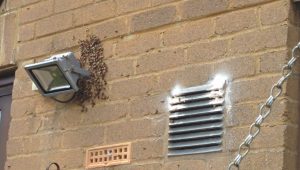
After the 3 (unsuccessful) treatments, the Irish guy from A1 Beekeepers said he could do no more; it being the worst infestation he’d ever seen (I wonder if he says that to all his customers?).
I then decided to start some serious investigations, beginning with taking bricks out of our back wall to scope out the size and whereabouts of the colony. Only to find they weren’t in the wall cavity at all.
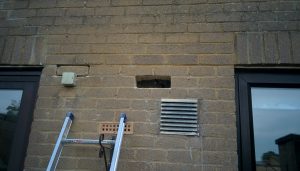
Nope, they’d manage to find their way across the cavity, through a large gap in some shockingly badly constructed masonry, and into the cavity above the kitchen ceiling. Although this sounds drastic, it was actually a good thing to be able to locate them: Now we could figure out what to do about them.
So I bought an endoscope – a mini (7mm diameter) camera on the end of a lead – that I could plug into my smartphone. I then drilled a number of exploratory holes in the kitchen ceiling adjacent to where I could see they were getting through the inner wall and stuck the endoscope in to see what was there. I was seeing lots of bees and honeycomb. Eventually, I struck gold. Well, honey, actually: It started dripping out of the ceiling, and I was able to figure that the nest was constrained between two joists, and to a length of about 1.2m in from the back wall. All very well, but what now?
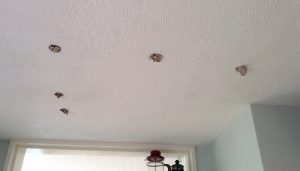
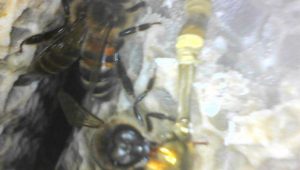
I spoke again to a local beekeeper again to explain what I’d found & to seek his help: he was very reluctant as there’d be nothing in it for him; the assumption being that – as they were a feral colony – they’d be infected with all manner of mites and diseases and he’d end up having to kill them all anyway. Eventually he agreed to remove them from the ceiling and take them away, as long as I actually did the ceiling removal bit. He’d have to quarantine them in a field well away from any of his other “cultivated” hives/colonies. In the meantime, I took the extractor fan grille out and sealed up the original access gap.
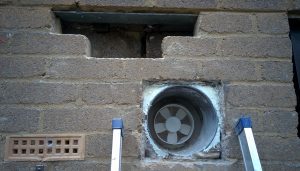
On the appointed day, and per instructions from Jeff the beekeeper, we cleared out the kitchen and covered everything in dust sheets. Jeff and colleague – Tom – arrived and we all donned beekeeper suits. It was then a simple matter of me sawing out the ceiling between the two joists, and Jeff & Tom removing comb. And what a lot of it there was!
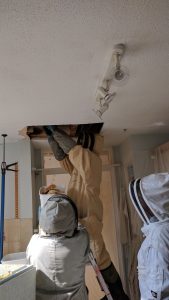
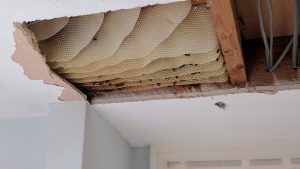

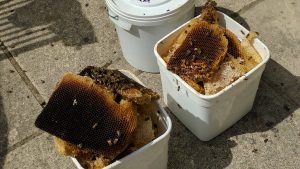
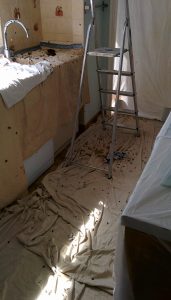

Jeff & Tom had brought along an empty portable hive: Once the queen was located and gingerly placed in a “gate”, much of the honeycomb was loaded into the portable hive, with the queen placed on top, and the hive closed up – apart from a small entrance hole. With the queen safely inside, the remaining colony – detecting her pheromones – gradually started to make their way into the portable hive.
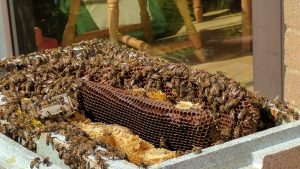
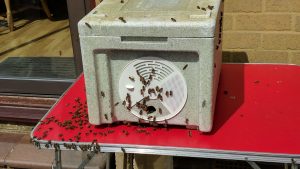
In the morning, Jeff came to collect the hive & take them away. Hooray!!

So now, we’re left with a wrecked kitchen with missing ceiling panel and lots of mess. Worse still, wasps have moved in, scenting the honey and coming to scavenge. But by now, we’ve temporarily blocked up the entrance in the brickwork so they can’t get through there, but the weather’s hot and we have doors & windows open. No more bees; just wasps.
Never one to miss an opportunity (?), I realised now’s the time to change the kitchen lighting, replacing the twenty year old lights with LED downlights. Of course, this entails completely rewiring the cabling in the ceiling, but as the ceiling is going to need re-plastering anyway… Obviously, I had to cut many more panels out of the ceiling to access the cabling/install new. Looks awful, but who cares as it’s going to be replastered anyway?
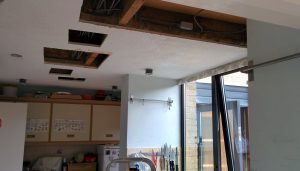
After the lighting’s done, I replaced the panels I’d removed. Only then, I thought: “wouldn’t it be nice to lay in a cable to facilitate underfloor heating in the bathroom?” The route is directly through the kitchen ceiling and then up into the bathroom airing cupboard. I’m not going to actually put the underfloor heating in yet – some time in the future we’ll refurbish the bathroom – but at least, we be able to have the underfloor heating if we want it. So that necessitated cutting out a couple more kitchen ceiling panels, doing a lot of precise measurement to drill through the wall from kitchen into garage (where our fuse box is) – the kitchen ceiling and garage roof are at different levels; I had a drill margin of error of a mere 20mm. Fortunately, that went fine & I hit the spot exactly. So I laid the cable in and was about to replace the ceiling panels again, when I realised I now had access to the meter tails: These are the big thick cables that run from the electricity meter to the fusebox. When I replaced the consumer unit/fuse box several years ago, I was troubled by the fact I couldn’t replace the meter tails which were – by contemporary regulation – undersized. They were simply inaccessible and couldn’t be pulled through. But now, with the kitchen ceiling open, I could see a chance to replace them. Of course, this meant two further panels being cut out of the ceiling to get better access, but the ceiling was going to be replastered anyway.

So on Monday, this week – with Joy away in Germany – off with the electricity and out with the cables: Main earth cable first. That pulled through relatively easily. Next, the live meter tail. The way to do these things is to connect the end of the new cable to the end of the old cable and pull the cable through. When I say connect, I mean go to great lengths to secure them together such that you don’t increase the overall diameter at the join between them (the cable has to go through tight spaces), and you ensure there’s no way the cables will come apart, because if they separate in an inaccessible point whilst pulling them through, then it’s game over. You don’t get a second chance at this. If they separate, then there’s no easy way of getting the new cable in there.
The cables separated. With one last almighty tug in the garage, I was left with the old cable in my hands, and the end of the new cable still somewhere in the wall cavity between kitchen and garage. Thus it was time for a sense of humour failure. As it happened, I could just about see the end of the new cable up behind the garage roof joist, and was just about able to get a pair of long-nosed pliers onto it, but it wouldn’t budge: couldn’t get a tight enough grip on the cable end. Time to call in reinforcements in the form of our neighbour opposite.
With my neighbour in the kitchen pushing the cable through the ceiling into the garage, and me in the garage trying to pull the cable through with my pliers, we eventually succeeded. I was very, very lucky.
With the neutral cable, I went to great lengths to ensure no repeat, and that pulled through without any major problems.

On Tuesday, we had the ceiling replastered. Hooray!

All that’s needed now – once the plaster’s dried-out – is to cut a hole to fit the last downlight and then repaint. That’s hopefully the end of the bee saga. [Now done]

And yet, I miss them in a strange way: we’ve become so used to seeing them, and observing their behaviour, and now they’re no longer there. They were definitely a memorable part of our life for a long time.